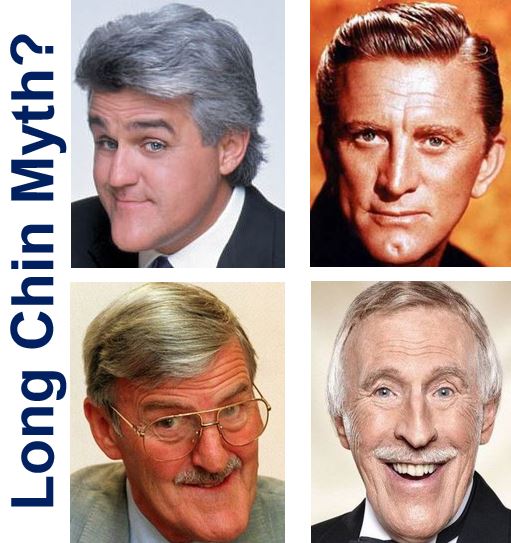The chin is a unique human feature, other animals, including chimps and gorillas, do not have chins. The human chin evolved because we started to cook – softer food meant we did not need to spend so long chewing and our jaws and teeth shrank, according to a new study.
Scientists have long known humans have chins and other animals don’t. However, nobody has been able to agree on the reason.
Some evolutionary anthropologists have suggested chins signaled sexual prowess and helped attract a mate, which would explain the popularity of Hollywood stars such as Charlton Heston and Kirk Douglas.

So, perhaps the rumour long-circulated by the media that celebrities with long chins have better sex is just a myth. Jay Leno (top left), Kirk Douglas (top right), Jimmy Hill (bottom left) and Bruce Forsyth.
However, both male and female humans have chins. In the animal kingdom, a feature aimed at attracting a mate is generally only found in one of the sexes.
Others theorized that it resulted from genetic drift – the process of change in the genetic makeup of a population due to random or chance events rather than by natural selection.
James Pampush, from the Department of Anthropology at the University of Florida, carried out a study on the evolution of the human chin and published his findings in the Journal of Human Evolution (citation below).
Chin evolved soon after we started to cook
Dr. Pampush says our chins evolved comparatively rapidly after our ancient ancestors started cooking their food, which made our jaws and teeth gradually shrink because we did not have to spend so long chewing.
The fact that other primates do not have chins is proof that the human chin must have evolved after our ancient human ancestors split off from other branches of the primate family.
The ‘genetic drift’ theory is not possible, Dr. Pampush points out, because the evolution of the human chin occurred seventy-seven times faster than the average genetic change, meaning it could not have been a random occurrence.
According to the study’s findings, the chin started to evolved between 6 million and 200,000 years ago. Dr. Pampush places his money on the chin beginning to emerge about 2 million years ago, which would coincide with the massive leap forward in human intelligence and the advent of cooking.
Chin evolution also coincided with brain growth
In an interview with the Independent, Dr. Pampush said:
“My guess is that it happened around two million years ago when there was a jump in brain size. We had a soft diet, and we no longer needed big teeth.”
“Around two million years ago there were a lot of changes to the ‘human-like’ animals. Homo erectus had a larger body size, much larger brains, was probably cooking and there’s a good chance they were using clothing. They are very human-like, but had no chins. I’m guessing the changes which ultimately lead to the chin are directly related to cooking, and indirectly related to larger brains and bodies.”
“Cooking enabled Homo erectus to spend much less time feeding, [which] allowed for smaller teeth, and the reduction in tooth size may have produced the chin as a spandrel (space between two arches).”
Citation: “Selection played a role in the evolution of the human chin,” James D. Pampush. Journal of Human Evolution. Published 15 March, 2015. DOI: 10.1016/j.jhevol.2015.02.005.
BBC Radio 4 Today
In this BBC Radio 4 Today show (below), Dr. Pampush talks about the evolution of the human chin.
